
Despite its city image, hiking in Dallas, TX offers surprisingly lush nature escapes. The city and its metro area boast over 200 miles of urban trails winding through parks, preserves, and along lakes. With a humid subtropical climate (long, sunny summers and mild winters), the Dallas outdoors season is almost year-round. From easy lakeside walks to rugged forest preserves, Dallas has a hidden diversity of hiking spots.
Introduction to Hiking in Dallas
Dallas is full of surprising variety. In fact, travel guides note that Big D “is filled with beautiful parks and forested hiking trails” even amid the suburbs. For example, the Cedar Ridge Nature Preserve (southwest Dallas) spans 600+ acres of upland forest and grasslands with 8–9 miles of trails. The Great Trinity Forest (south Dallas) hosts trails like the one-mile Texas Buckeye Trail, where spring brings blooming buckeye trees and river views. Nearby, Arbor Hills Nature Preserve in Plano (north of Dallas) covers 200 acres of bottomland forest and prairie with mixed paved and natural paths. These varied ecosystems – from limestone bluffs to oak woodlands – give Dallas area hikers a taste of hill country and wetlands just outside the city.
Why Dallas is a Surprisingly Great Hiking Destination
It’s true that Dallas isn’t known for mountains, but its parks and trails are hidden gems. Many city parks connect to larger greenways via the Dallas Trail Plan. For instance, Cedar Ridge Preserve is one of the highest points in the metro (up to 755 ft elevation) and offers steep, scenic hikes under oak and juniper. Forests like The Woods at Valley View (North Dallas) are stitched into neighborhoods, so you can go from the suburbs straight into nature. In spring and fall Dallas’s hikes burst with wildflowers and migratory birds – even endangered species like the golden-cheeked warbler nest in the escarpments.
Nearby Fort Worth extends the adventure: the Fort Worth Nature Center & Refuge is a 3,621-acre park with 20 miles of trails and roaming bison. In short, Dallas hides real outdoors experiences. As one guide puts it, you’ll find “short and easy routes” right in the city and more challenging hikes in the greenbelts, all without leaving North Texas.
Top 10 Best Hikes in Dallas
Exploring the best hikes in Dallas reveals just how underrated the natural beauty in this urban Texan hub truly is. From peaceful nature preserves and forest trails to scenic ridge walks and family-friendly loops, the hiking in Dallas TX scene offers something for everyone. Whether you’re an outdoor enthusiast, a photographer chasing golden hour, or just someone looking for fresh air and adventure, these hiking places in Dallas will leave you inspired.
From hiking near Dallas TX to deep pockets of nature within the city limits, the following trails will elevate your weekend plans—both literally and metaphorically. So grab your gear, lace up your hiking boots Dallas TX style, and explore these places to hike in Dallas that even locals rave about.
1. Oak Cliff Nature Preserve Dallas TX
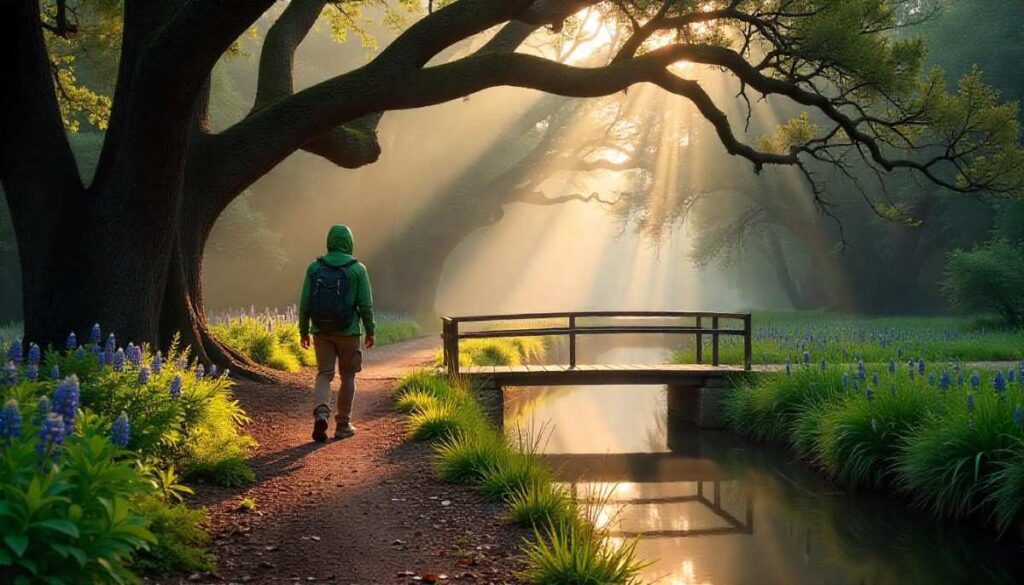
Introduction:
The Oak Cliff Nature Preserve in Dallas is like a hidden backyard forest right inside the city. It has tall trees, rocky hills, and bright wildflowers in spring. You can see birds of prey like hawks and maybe even deer as you walk. The trails go up and down gentle hills, giving you a great view of Dallas on clear days. It feels quiet and peaceful, away from traffic, even though it is just a few miles from downtown. Kids and families love walking here because it feels safe and fun to explore nature close to the city.
Trail Distance, Elevation, Difficulty, and Permit:
- Distance: About 3 miles of interconnected loop trails, plus extra paths to explore.
- Elevation Gain: Around 200 feet of gentle climbs and declines.
- Difficulty: Easy to Moderate (good for beginners and kids with some hills).
- Permit: No permit required; the park is free and open to the public.
Best Time to Visit:
Early spring and fall are the best times tob visit to enjoy wildflowers and cool weather. Summer can be very hot, so try going in the morning or late afternoon and bring plenty of water. The trees give good shade, so even a sunny day can feel nice on the trails. In winter the weather can be chilly and some plants rest, but the preserve is less crowded. On clear days, you might even catch the sunset over the Dallas skyline from high points on the trail.
Personal Tips & Safety Precautions:
- Always bring lots of water, especially in the Texas summer heat.
- Wear sturdy shoes because the rocky ground can be uneven and slippery if it’s wet. A hat and sunscreen will help protect you from the sun on open sections.
- Watch out for poison ivy and snakes, and stay on marked trails to avoid surprises.
- Remember to pack out any trash and keep dogs on a leash to protect the wildlife and plants.
2. Great Trinity Forest Trail

Introduction:
The Great Trinity Forest Trail winds through the largest urban forest in the United States, right here in Dallas. The air feels fresh with trees and wetland sounds all around. You might see turtles and deer, and many water birds like herons near the Trinity River. The trail has shady spots under big oak and willow trees, and some paths floating on wetlands. It feels far from city noise even though you’re inside Dallas. Families and nature lovers like it because it’s peaceful and full of birds and butterflies.
Trail Distance, Elevation, Difficulty, and Permit:
- Distance: Roughly 5 miles of connected trails; you can do short loops or longer trips.
- Elevation Gain: Almost flat terrain (very little up-and-down).
- Difficulty: Easy (smooth dirt and boardwalk paths suitable for hikers and bikers).
- Permit: No permit or fee; it’s a free public trail.
Best Time to Visit:
Spring and fall are perfect times to visit for cool weather and lots of wildlife. In spring, wildflowers bloom and you’ll hear frogs and songbirds. In fall, the air is cooler and trees show more color.
Personal Tips & Safety Precautions:
- Bring insect repellent because wetland areas have mosquitoes.
- Pack plenty of water and snacks since there are no shops in the forest.
- If you go alone, tell someone when to expect you back. The trail is generally safe, but it’s good to hike with a friend.
3. Leonhardt Lagoon Nature Walk
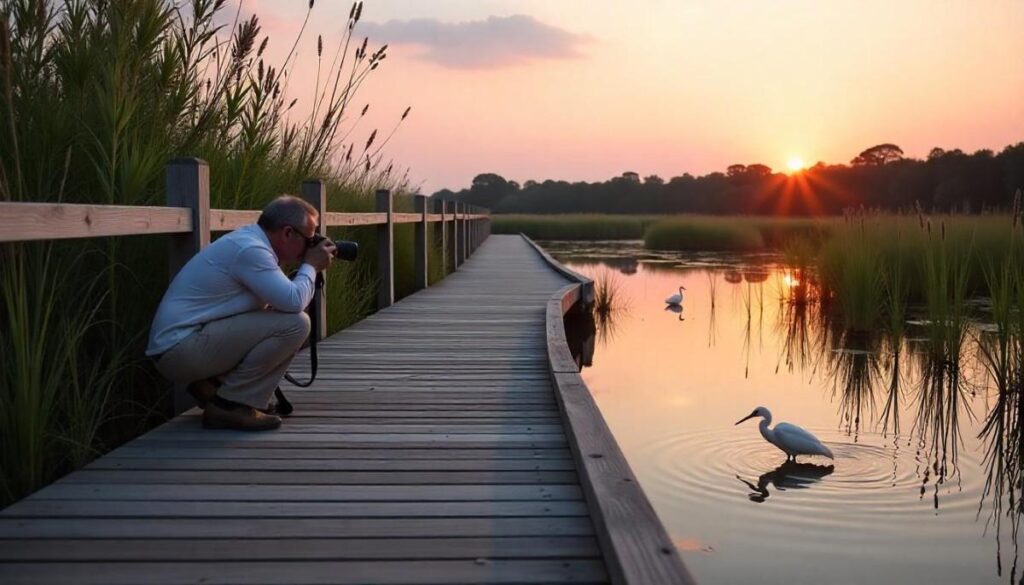
Introduction:
The Leonhardt Lagoon Nature Walk is a short, easy trail around a quiet lagoon near Dallas. It’s great for families or anyone who wants a gentle stroll in nature. You walk on flat paths beside calm water where ducks and turtles live. Colorful flowers and tall trees line the trail, so it feels like a peaceful garden. This spot is easy to reach and popular with people of all ages. You might even see fish or frogs, and sometimes herons wading in the shallow water.
Trail Distance, Elevation, Difficulty, and Permit:
- Distance: About 1 mile loop (short walk).
- Elevation Gain: Minimal (almost completely flat).
- Difficulty: Very Easy (paved or well-maintained path, good for kids and strollers).
- Permit: No permit needed; open to the public.
Best Time to Visit:
Early morning or late afternoon are nice times to visit for calm water and cooler air. Spring and fall have mild temperatures and more wildlife activity. Summer afternoons can be hot, but the shade from trees along the trail helps. Birds and frogs are active in warmer seasons. Winter is cool and pleasant here, and you might spot different water birds that come to the lagoon.
Personal Tips & Safety Precautions:
- Even though it’s an easy walk, bring water and wear sun protection on hot days.
- Watch your step if it has rained, since surfaces might be slippery.
- If you bring pets, keep them leashed to stay safe around water and wildlife.
- This area is open and family-friendly.
4. Big Cedar Wilderness Trail Dallas
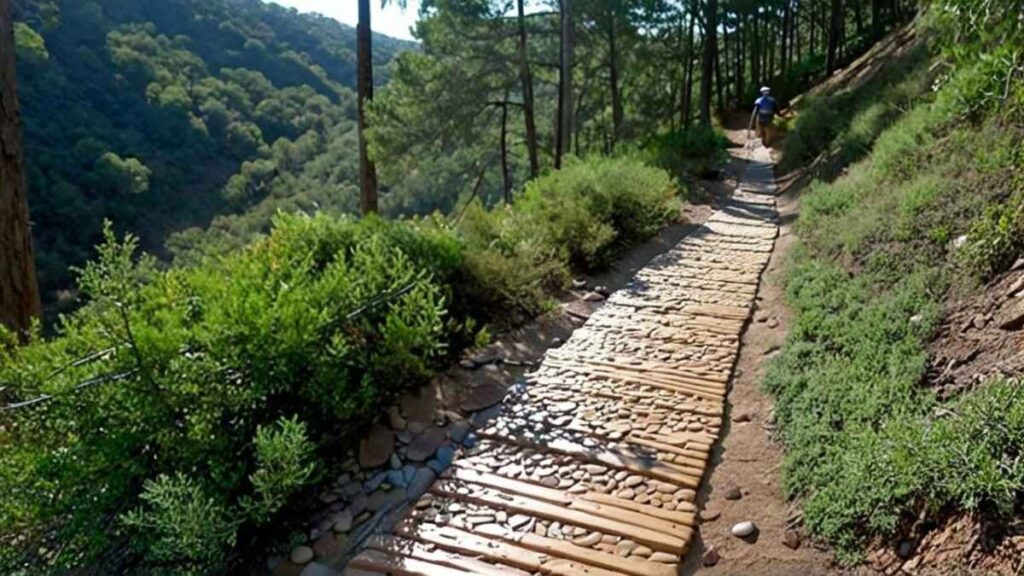
Introduction:
The Big Cedar Wilderness Trail is a long, quiet hike near Dallas with beautiful forest and lake views. This trail is inside Cedar Hill State Park, so you’ll see big oak and cedar trees, plus colorful wildflowers. The path sometimes follows a hilltop ridge, giving great views of Joe Pool Lake and the distant Dallas hills. It feels like a real wilderness adventure just outside the city. Many hikers and horseback riders use this trail because it stretches for many miles through peaceful nature.
Trail Distance, Elevation, Difficulty, and Permit:
- Distance: About 12 miles (full loop with connecting routes); you can do shorter sections too.
- Elevation Gain: Moderate (about 500 feet of climbs over the full loop).
- Difficulty: Moderate to Strenuous (due to length and some uphill parts).
- Permit: Requires a Texas State Park entry fee (pay at the gate or show a state park pass).
Best Time to Visit:
Fall and spring are the best times to visit for comfortable weather and scenic beauty. In spring, wildflowers like bluebonnets blanket the hills, and in fall the trees have colorful leaves.
Personal Tips & Safety Precautions:
- Get a park map or trail guide before you go, to avoid missing turns.
- Let someone know if you plan to tackle the full loop, and consider hiking with a buddy.
- Watch for snakes on the ground and check for ticks afterward.
- After heavy rain, parts of the trail may be muddy, so be prepared for slippery conditions.
5. Buckeye Trail Commons Dallas

Introduction:
The Buckeye Trail Commons (in the same Oak Cliff area as the Oak Cliff Nature Preserve) is a simple and gentle trail in Dallas. The path follows a small creek through a green common area, with grasslands and shady spots under trees. It’s a quiet place where neighbors walk their dogs and families can enjoy a picnic. In spring, yellow wildflowers bloom along the edges, and birds like red-tailed hawks fly overhead. The trail is easy and relaxing, good for beginners or a quick nature break during your day.
Trail Distance, Elevation, Difficulty, and Permit:
- Distance: About 1.5 miles of easy trails (out-and-back or loop).
- Elevation Gain: Very little (nearly flat terrain).
- Difficulty: Very Easy (paved or smooth gravel trails suitable for walking and biking).
- Permit: No permit or fee; open to the public year-round.
Best Time to Visit:
Spring and fall are great times to visit for mild weather and colorful plants. In spring, the native flowers and grasses are most vibrant. Fall is cooler and you might see migrating birds overhead.
Personal Tips & Safety Precautions:
- This trail is very easy, but still wear sunscreen and bring water on warm days. Watch for any uneven pavement or tree roots.
- If biking, ride slowly and be courteous to walkers. The trail is near neighborhoods, so be aware of streets and parking areas at trailheads.
- Always respect posted rules and leave the place as clean as you found it to keep this community space nice for everyone.
6. Cedar Mountain – Dallas County Nature Preserve
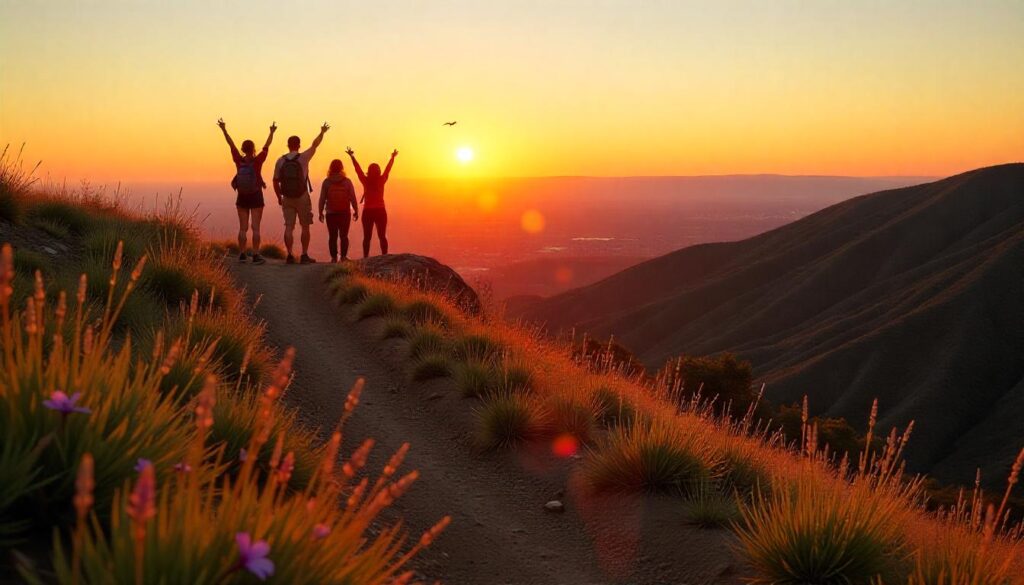
Introduction
Cedar Mountain is a hidden gem in the Dallas County Nature Preserve. This trail winds through cedar- and oak-covered hills, offering hikers sweeping views of the surrounding area. It’s popular with both hikers and mountain bikers looking for a bit of rugged terrain close to Dallas. The rocky outcrops and native cedar forests make the scenery feel like a mini mountain escape in North Texas. Wildlife such as deer and songbirds are commonly sighted here, adding to the natural charm. The trail’s unique elevation changes and cedar-covered bluffs really set it apart from flatter city parks. Overall, Cedar Mountain is a fun spot to test your legs with some uphill sections while still being very close to city amenities.
Trail Distance, Elevation, Difficulty, and Permit
- Distance: ~6.5 miles (round trip)
- Elevation Gain: ~400 feet (rolling hills)
- Difficulty: Moderate – steady climbs and uneven terrain
- Permit: None required (open to public)
Best Time to Visit
The best time to hike Cedar Mountain is spring or fall. Spring brings wildflowers and mild weather, while fall offers cooler temperatures and colorful foliage. Early morning or late afternoon hikes are ideal to avoid the hot Texas sun. Summers can be very hot and dry, so it’s best to skip midday summer hikes. Winters are cooler but can be muddy after rain, so checking trail conditions is wise. In any season, try to hike on a clear day to enjoy the expansive views from the higher points.
Personal Tips & Safety Precautions
- Bring Plenty of Water: Texas can get very hot, even on shorter hikes. Always pack more water than you think you’ll need and take regular sips to stay hydrated.
- Wear Sturdy Shoes: The trail is rocky and uneven in places. Hiking shoes or boots with good grip will help prevent slips on loose rocks or gravel.
- Use Sun Protection: The trails have exposed sections on the ridges. Wear sunscreen, a hat, and sunglasses to protect against strong sun and UV rays.
- Watch for Wildlife: You may see deer, rabbits, or snakes. Give all animals space and do not disturb them. If you see a snake (even non-venomous ones), back away slowly.
- Stay on Marked Trails: It’s easy to wander off on informal paths. Follow the marked trail to avoid getting lost. Inform someone of your plans and estimated return time for extra safety.
7. Windmill Hill – Dallas County Nature Preserve
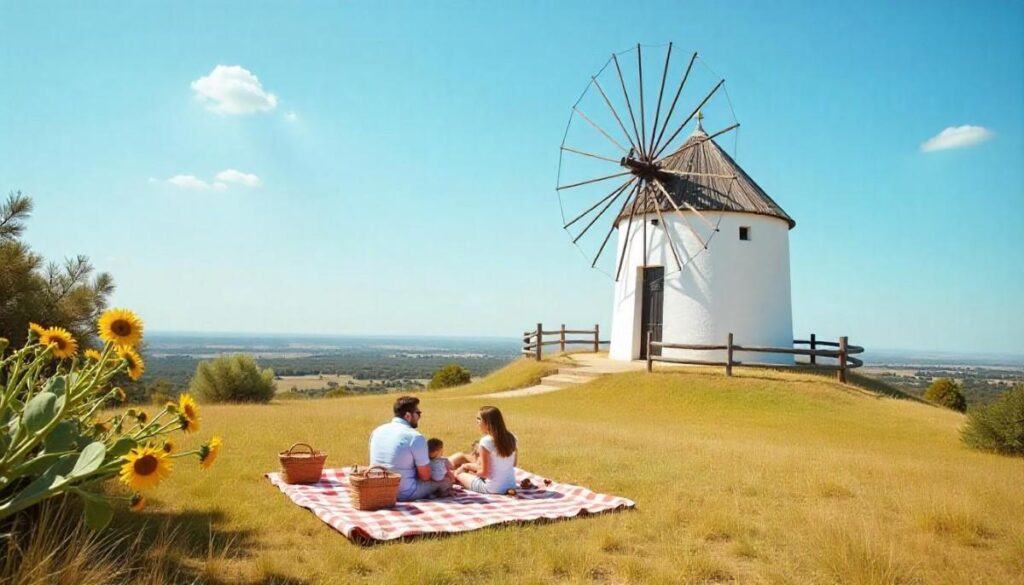
Introduction
Windmill Hill is another scenic trail in the Dallas County Nature Preserve. It gets its name from a historic old windmill that overlooks the valley. The trail offers open grassland areas and gentle rises, making it feel like hiking through a peaceful prairie. Views from the hilltop windmill site include native tall grasses and a glimpse of the Dallas skyline in the distance. The open fields are great for wildflower viewing in spring, and the prairie grasses create a golden landscape in fall. Windmill Hill is less rocky than Cedar Mountain, providing an easier walk while still giving that feeling of being “away in nature.” This trail’s unique mix of open meadow, cedar trees, and a nostalgic windmill landmark makes it a memorable Dallas hike.
Trail Distance, Elevation, Difficulty, and Permit
- Distance: ~4 miles (loop)
- Elevation Gain: ~300 feet
- Difficulty: Easy to Moderate – gentle slopes and mostly grassy terrain
- Permit: None required (open to public)
Best Time to Visit
The best time to hike Windmill Hill is during spring and fall. Spring offers colorful wildflowers and moderate temperatures. Fall brings mild weather and beautiful golden grasslands. Summer afternoons can be very hot with little shade in the open prairie, so early mornings or later afternoons are better. Winter hikes are brisk but often clear—just dress warmly. Avoid stormy days as the elevated hilltop can be exposed to winds and lightning. A calm fall morning or spring evening will reward you with spectacular skies and cool breezes on the hilltop.
Personal Tips & Safety Precautions
- Dress in Layers: The open hilltop can be breezy or sunny. Layer up so you can stay warm early on and cool off as you hike.
- Sun and Wind Protection: There’s little shade on this trail. Wear a sun hat and bring sunglasses. On windy days, watch out for loose hats or jackets.
- Check Trail Map: Windmill Hill has a few intersecting paths. Use a trail map or GPS and follow signs to stay on track.
- Carry Snacks: Although it’s not a very long hike, carrying some snacks like nuts or energy bars helps keep your energy up【REI†L2-L5】.
- Stay Hydrated: Even moderate trails require water in Texas. Always bring a water bottle and drink often.
- Use Caution on Exposed Ground: After rain the soil may be soft or slippery. Tread carefully and consider hiking poles for balance.
8. Harry Moss Park – Dallas, TX
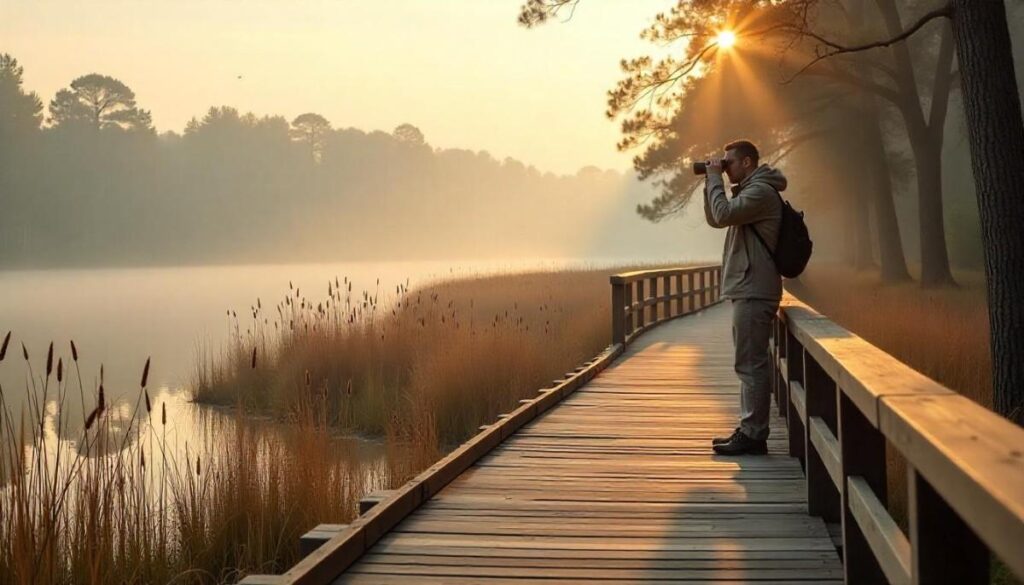
Introduction
Harry Moss Park is a neighborhood green space in the Dallas area that’s perfect for an easy, family-friendly hike. The trail winds through shady woods and runs alongside a calm creek, creating a cool, peaceful environment even in warmer months. It feels like a small nature escape within the city. The landscape features towering cedar and oak trees, and you might spot squirrels or birds around every turn. In the fall, the trees change color, making the entire area very scenic. This park is popular with local families, joggers, and birdwatchers. The unique charm of Harry Moss Park comes from its creekside trail and woodland setting – you forget you’re still in Dallas! It’s ideal for a short nature walk or a gentle hike close to home.
Trail Distance, Elevation, Difficulty, and Permit
- Distance: ~2 miles (loop)
- Elevation Gain: Minimal (nearly flat)
- Difficulty: Easy – suitable for beginners and kids
- Permit: None (free public park)
Best Time to Visit
Harry Moss Park is best enjoyed in spring, fall, or mild winter days. Spring brings wildflowers and active birdlife. Fall offers cooler weather and pretty leaf colors. The canopy makes summer heat bearable under shade, but morning or evening visits are most comfortable. If you hike after heavy rain, watch for slick boardwalks over the creek. Early mornings in warmer months may have dew or wet grass, so wear shoes that can handle moisture.
Personal Tips & Safety Precautions
- Wear Insect Repellent: Ticks and mosquitoes like woodsy areas. Apply bug spray to clothes and skin, especially below the knee and around ankles.
- Stay on the Boardwalks: Parts of the trail have wooden boardwalks and bridges. These can be slippery when wet. Walk slowly and hold any available railings.
- Keep Dogs Leashed: If you bring a pet, keep it on a leash. Wildlife and other visitors are common, so leashes help everyone stay safe.
- Check Weather: The trail can flood or be muddy after heavy rain. If it’s been stormy, wear shoes that can get wet and check local news or park notices for closures.
- Watch for Creek Snails: The creek may have small creatures like fish or snails; keep kids from picking them up and put anything back carefully.
- Trail Markings: The trail in Harry Moss Park is easy to follow, but keep an eye out for trail markers so you complete the loop back to the parking area.
9. Vineyards at Forest Edge – Dallas, TX

Introduction
The Vineyards at Forest Edge combine the joys of hiking with wine-tasting. This trail is located in Dallas’s outskirts and meanders through rolling hills of grapevines and forest edge scenery. It’s a unique hike because you’re surrounded by neat vineyard rows one moment and wild forest the next. Hike here feels like a countryside getaway without leaving Dallas. You might see winemaking equipment and rustic barns along the way, giving it a charming vineyard feel. The trail is dotted with occasional benches where you can pause and enjoy vineyard views. Because it’s a working vineyard, the air smells fresh and earthy. This hike stands out as a relaxing walk — you can even pair it with a visit to the tasting room after! Overall, it’s part vineyard tour, part forest stroll, making it a delightful and different Dallas-area trail.
Trail Distance, Elevation, Difficulty, and Permit
- Distance: ~3 miles (out-and-back loop around vineyard)
- Elevation Gain: ~150 feet (gently rolling terrain)
- Difficulty: Easy – mostly flat with small gentle hills
- Permit: None required, but check vineyard hours (may have a tasting fee)
Best Time to Visit
Visit Forest Edge vineyards in late spring through summer for the best experience. Late spring shows grapevines in bloom and colorful wildflowers. Summer is grape growing season, so you’ll see lush green vines (just avoid the midday heat!). Autumn brings harvest time – the vines turn golden and deep purple, and the winemaker might be busy picking grapes. Winters are mild but often bare in the vineyard, so it’s less scenic.
Personal Tips & Safety Precautions
- Bring Sun Protection: Much of this trail is open to the sky between vineyard rows. Hat, sunglasses, and sunscreen are essential on sunny days.
- Check Vineyard Hours: The tasting room usually opens in the afternoon. If you plan to combine hike and wine, confirm hours online first.
- Stay on Vineyard Paths: Stick to marked paths – vines are private property, so don’t wander into fenced areas or between rows without permission.
- Wear Comfortable Shoes: The ground can be uneven farm terrain. Sneakers or hiking shoes with a decent sole will keep you comfortable on dirt paths.
- Hydrate and Snack: Bring a reusable water bottle and light snacks. Some hikes may only have a tasting area after you finish, so plan accordingly.
- Respect Wildlife: The vineyard is also habitat for small wildlife (rabbits, birds). Observe from a distance and don’t disturb any nests or animals.
10. Four Sisters Hiking Trail – Dallas, TX
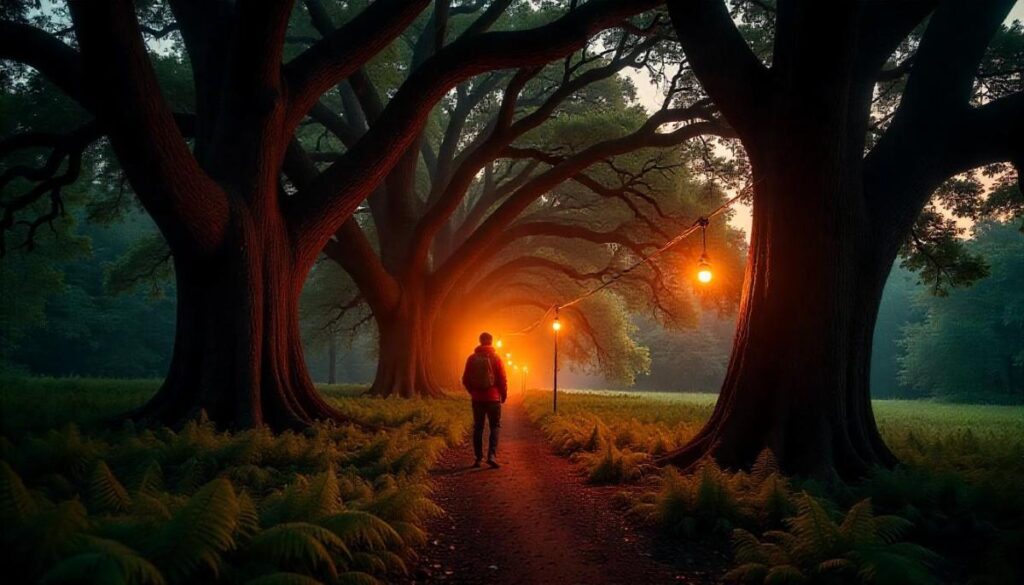
Introduction
The Four Sisters Trail is a charming urban nature trail located at Four Sisters Park in northwest Dallas. This hike loops around four serene lakes (hence the name “Four Sisters”), passing through woodlands and marshy areas. It’s a great example of city parks with rich natural habitats. The trail showcases both mature trees and sunny lake vistas. You’ll often see ducks, herons, and other waterfowl on the lakes. In spring and summer, wildflowers and cattails line parts of the path. In winter, the lakes freeze and the trees look mystical in frost. The scenery changes a lot with the seasons – it’s peaceful at dawn or dusk when wildlife is most active. The Four Sisters Trail is special for offering a relatively long and varied loop (urban lakes, woods, meadows) entirely within Dallas city limits.
Trail Distance, Elevation, Difficulty, and Permit
- Distance: ~4 miles (complete loop around lakes)
- Elevation Gain: ~200 feet (hilly in sections)
- Difficulty: Moderate – some hills, but well-groomed path
- Permit: None required (park trail, free access)
Best Time to Visit
The best times for Four Sisters are spring and fall. Spring brings green foliage and active wildlife. Fall has cool weather and colorful leaves. Summer can work with an early start to avoid midday heat, and dawn hikes reward you with wildlife activity and mist over the lakes. In winter, it’s chilly but very quiet – dressing warmly is key if you hike in the morning.
Personal Tips & Safety Precautions
- Bug Spray: Because there’s water nearby, use mosquito repellent in spring and summer. Ticks can also be found in grassy or wooded parts, so check yourself after hiking.
- Wear Bright Clothing: This park is popular; hikers, runners, and cyclists may also be around. Bright clothes help others see you on the trail.
- Respect the Lakes: Don’t throw anything into the lakes. Leave the water clean for wildlife. If fishing is allowed, follow local rules (usually a license is required).
- Use Caution Near Water: Watch young children near lake edges. The banks can be slippery, and water can be deep.
- Flashlight for Dusk: If you stay late, bring a headlamp or flashlight as the path can get dark quickly after sunset.
- Follow Trail Etiquette: Keep to the right when passing others and yield to wildlife. If you bring a dog, keep it leashed; Dallas city parks generally require it.
Quick Comparison: Top 10 Best Hikes in Dallas
| Trail Name | Distance | Elevation Gain | Difficulty | Season | Permit Required |
|---|---|---|---|---|---|
| Oak Cliff Nature Preserve | 8 miles of loops | 200–300 ft | ⭐️⭐️⭐️ Moderate | Fall to Spring | None |
| Great Trinity Forest Trail | 8.5 miles one way | Minimal | ⭐️⭐️ Easy | Fall & Winter | None |
| Leonhardt Lagoon Nature Walk | ~0.5 mile loop | Flat | ⭐️ Easy | Year-round | None |
| Big Cedar Wilderness Trail | ~6 miles total | Up to 300 ft | ⭐️⭐️⭐️ Moderate | Fall to Spring | None |
| Buckeye Trail Commons | 4.3 miles round trip | Minimal | ⭐️⭐️ Easy | Fall & Spring | None |
| Cedar Mountain – Dallas Co. Preserve | 2 miles round trip | ~300 ft | ⭐️⭐️⭐️ Moderate | Fall to Spring | None |
| Windmill Hill – Dallas Co. Preserve | 3 miles round trip | ~200 ft | ⭐️⭐️ Easy to Moderate | Fall to Spring | None |
| Harry Moss Park – Dallas, TX | ~5.5 miles loops | Minimal | ⭐️⭐️ Moderate | Year-round | None |
| Vineyards at Forest Edge – Dallas, TX | 2.5 miles loop | Flat | ⭐️⭐️ Easy | Fall to Spring | None |
| Four Sisters Hiking Trail – Dallas, TX | 1.5 miles loop | Flat | ⭐️⭐️ Easy | Fall to Spring | None |
Planning Your Dallas Hike

What to Pack for Hiking in Dallas
Pack smart: bring plenty of water and snacks. Experts advise carrying at least one liter of water per hour of hiking, plus electrolytes or sports drink in summer. In your daypack, include a first-aid kit, navigation tools (map/compass or GPS), and a multi-tool or knife. Food should be easy, high-energy trail snacks; you might not think you need them for a short hike, but a sudden energy drop can spoil the fun.
Sun protection is essential. Bring sunscreen, lip balm with SPF, and a wide-brim hat or visor. Sunglasses and light-colored, UPF-rated clothing help keep you cool. Insect repellent is wise too – even in city parks Dallas has mosquitoes and ticks, so treat clothing or spray on repellent. A lightweight rain jacket or windbreaker is useful in case of sudden showers. If you plan to hike late or overnight, pack a headlamp or flashlight – along with extra batteries – and an emergency.
What to Wear for Hiking in Dallas
Choose moisture-wicking, breathable fabrics. A lightweight long-sleeve shirt and hiking pants will protect you from sun and brush. Pack an extra warm layer (fleece or light jacket) if starting before dawn – temperatures can be cool, especially near reservoirs. Good trail shoes are a must: wear sturdy, broken-in hiking boots or trail runners with grip. Even on flat Dallas trails, boots give ankle support and protection.
Socks matter: synthetic or wool hiking socks prevent blisters and wick sweat. For summer hikes, lightweight hiking shorts are fine, but carry a long-sleeve shirt in your pack (for sun and bugsr). In winter or early spring, layers (including rain gear) make sense since Dallas weather can swing 20–30°F during the day. Finally, don’t forget a hat and sunglasses – the Texas sun is strong year-round. For detailed hiking clothing visit our hiking wearable guide.
Other Experience-Based Hikes in Dallas
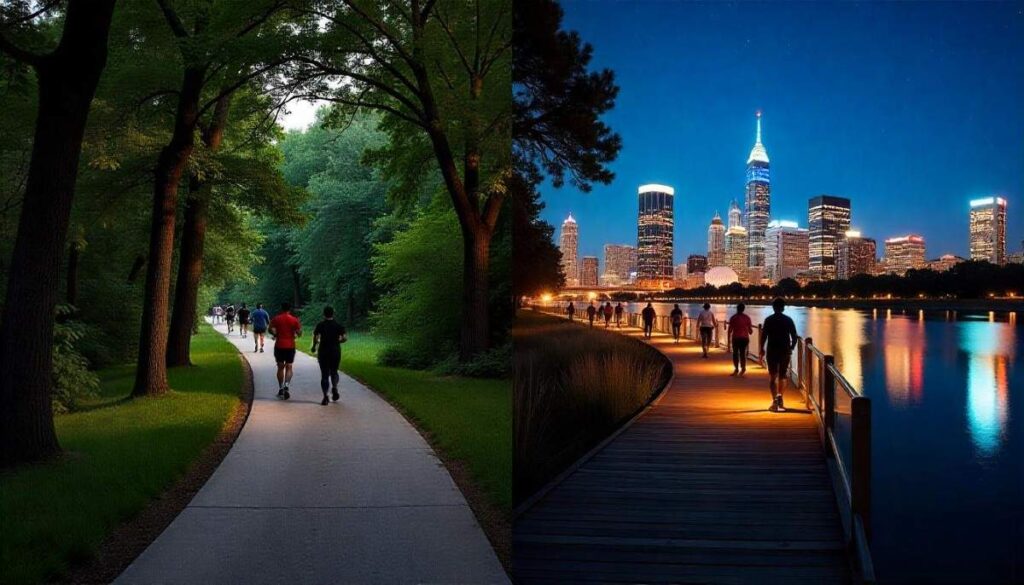
Dallas isn’t just about day hikes in city parks. The metro area offers unique hiking experiences and themed outings. Below we cover some of the most popular: multi-city Dallas–Fort Worth trails, and even night hiking options under the stars.
Hiking in Dallas–Fort Worth
The entire DFW area is within reach for day trips, vastly expanding your trail options. Fort Worth alone has plenty of green space: for instance, Fort Worth Nature Center & Refuge is a 3,621-acre park with over 20 miles of trail. In that refuge, bison (American buffalo) still roam free, giving hikers a taste of the wild (see image above). Trinity Park in Fort Worth (near the zoo) provides easy paved trails by the river for family outings. The vast Trinity Trails network connects many parks on the Fort Worth side.
Bison graze at the Fort Worth Nature Center & Refuge – a huge city-owned park with miles of hiking trails.
On the Dallas side, a short drive brings more. Cedar Hill State Park (on Joe Pool Lake) spans 1,826 acres and offers hiking, biking and even swimming. It has trails for all levels and campsites if you want to stay overnight. Further north, Eisenhower State Park (Lake Texoma, near Denison) has 4+ miles of trails through rocky bluffs and pine forest; it’s popular for rock scrambling and lakeside hikes.
If you head east toward Arlington/Lake Arlington, check out River Legacy Park (over 1,000 acres of woods and prairies). To the west, Cleburne State Park (further out) has small canyons and cedar forests. In short, a central location like Dallas means you can easily day-hike nearby state parks and wilderness areas – from the wetlands of Fort Worth to the rocky escarpments around Lake Texoma.
Night Hiking in Dallas

For a different thrill, try hiking or walking after dark. In Dallas, some trails and parks host moonlight hikes or simply become evening walkways. Popular spots for night hikes include lighted city trails (like the Katy Trail in Uptown or the levee paths of White Rock Lake after sunset). You can often find full-moon group hikes on weekends at places like Cedar Ridge Preserve or Trinity River.
When night hiking, safety is key: carry a reliable headlamp or flashlight, wear reflective gear, and go with a friend or group. Stick to familiar trails or well-trafficked areas. Watch for nocturnal wildlife (opossums, coyotes, raccoons) that come out at dusk. Always obey park hours – some parks close by 10pm – and be extra cautious near water or cliffs. A night hike can reward you with stars and cooler air, but be prepared and stay on marked paths.
Best Night & Evening Walk Trails in Dallas
- White Rock Lake Loop (Dallas): A 9-mile trail around White Rock Lake. Parts of the lake trail are lit, and the path is flat. Evening walkers often stay on the wider, popular side of the loop. (Park hours vary by section.)
- Katy Trail (Downtown/Uptown): A paved 3.5-mile north–south corridor through the city. It’s well-lit in many sections (especially near downtown). Great for an easy evening stroll.
- Trinity River Trail (Fort Worth): If you cross over to Fort Worth, the river trails on the north and south banks are lit near downtown (near Panther Island). These make a nice city-night walk.
- Cedar Ridge Preserve Full Moon Hikes: While Cedar Ridge usually closes at dark, Dallas Parks sometimes organizes special Full Moon Hikes on certain Saturdays. Check the Dallas Park calendar. Otherwise, try the Woods at Valley View park trails in North Dallas (they are open 6 am–10 pm and can be walked at twilight).
Always plan your route ahead of time and make sure your phone’s GPS works. Even on evening walks, carry water and a light snack.
Where to Stay in Dallas for Hikers

Choosing the right neighborhood can cut your travel time to trails. Dallas offers everything from downtown hotels to cabin-style retreats near preserves. Below are some area suggestions and lodging examples that put hikers close to the action. Wherever you stay, be sure to check for nearby grocery or gear stores and park shuttle options.
Areas to Stay Near Hiking Trails
- North Dallas (Preston, Addison, Plano): This area puts you near Arbor Hills, LBJ Elm Fork trails and White Rock/Quarry. Hotels along the Dallas North Tollway (Preston Road) and George Bush Turnpike – such as the Hyatt Place Dallas/Addison, Courtyard by Marriott Dallas/Plano, or Residence Inn Dallas/Plano – offer easy access to multiple trailheads. These hotels are near major highways (DNT, I‑635) so you can reach Spring Creek Forest or Lewisville Lake trails in 20–30 minutes. The historic Highland Park area (near White Rock Lake) has options like The Highland Dallas or a budget-friendly Motel 6 Dallas East for quick lake access.
- Cedar Hill / Oak Cliff Preserve: Cedar Hill State Park and the Big Cedar Wilderness Trail sit just southwest of Dallas. Nearby lodging (Cedar Hill/Mansfield) includes Holiday Inn Express & Suites Cedar Hill and Hampton Inn & Suites Dallas/Mansfield, both a short drive from Joe Pool Lake. These cater to hikers and anglers alike. Closer in, the Oak Cliff neighborhood has boutique hotels and short-term rentals; for example, an Airbnb “cabin-inspired” cottage in Cedar Hill or “The Vlasova” lodge can give a rustic feel. In summer, consider camping at Cedar Hill State Park’s campgrounds or renting one of their group cabins (if available).
- Fort Worth and Grapevine Area: If you plan to day-hike around Fort Worth or Grapevine Lake, stay on the west side. Downtown Fort Worth has hotels like Omni Fort Worth or Hyatt Place Fort Worth/Downtown, putting you on the Trinity Trails. In Grapevine (northeast of Dallas), family resorts like Great Wolf Lodge Grapevine or Gaylord Texan Resort are handy, since Grapevine Lake and its trails are steps away. Budget chains (Best Western, Holiday Inn Express) along Highway 114 near DFW Airport also work – you’ll have a short drive to Lake Grapevine trails or to the south to reach South Lake hiking areas.
Lodging Options
- Budget-friendly stays near Dallas trails: Dallas has many affordable chains. For example, La Quinta Inn & Suites Dallas Love Field and Motel 6 Dallas East – Park Cities are low-cost picks not far from White Rock Lake or Cedar Ridge. TownePlace Suites Dallas North or Comfort Suites Garland/Dallas can be useful for North Dallas trails. Check for deals on extended-stay places or hostels if backpacking – some travelers report affordable rates at places like Hostel HG Garden. Camping is the ultimate budget option: reserve a campsite at Cedar Hill State Park or Ray Roberts Lake if you have gear.
- Cabins and eco-lodges near nature preserves: For an immersive nature stay, look outside the city. There aren’t rustic cabins in Dallas city limits, but nearby areas have options. For instance, Ray Roberts Lake State Park and Eisenhower State Park have cabin rentals or yurt/eco-glamping sites. Closer in, some Airbnb listings offer “cabin-style” homes near Dallas trails (search “cabin Cedar Hill” or “treehouse Dallas”). There are also family-owned lodges around Lake Grapevine that market themselves as nature retreats. If you drive an hour, consider the Anderson Island RV/Cabin Resort near Lake Palestine (East Texas) for waterfront cabins. In all cases, be sure to book well in advance, especially for summer weekends.
Seasonal Hiking & Best of Dallas Texas
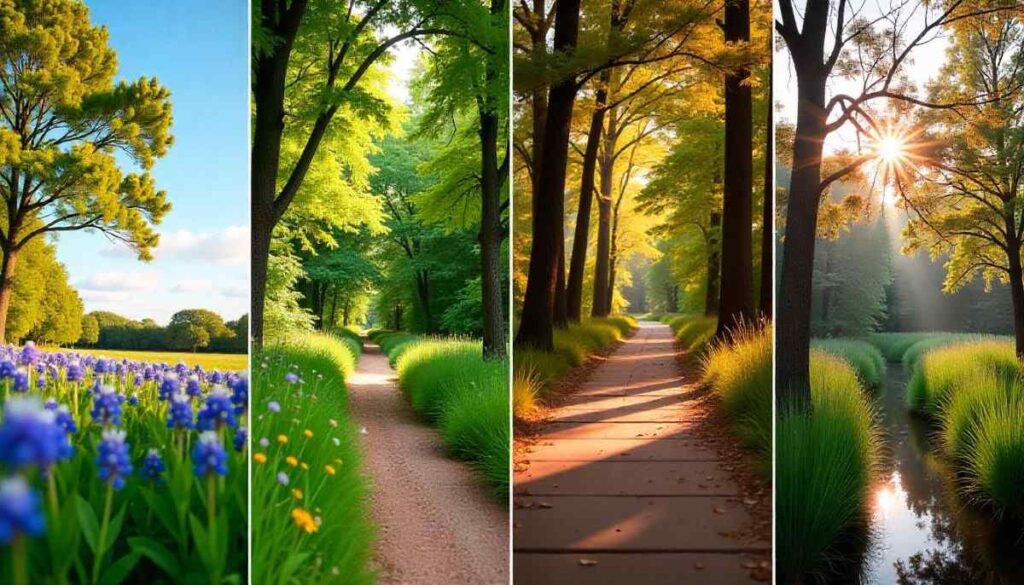
Spring Wildflower Hikes in Dallas
In spring, hiking in Dallas transforms into a vibrant tapestry of bluebonnets, Indian paintbrush, and wild violets. Trails like Cedar Ridge Nature Preserve and Buckeye Trail Commons Dallas burst with blooms, making them top picks for spring wildflower hikes in Dallas. Experts recommend visiting between late March and early April when wildflowers are at peak bloom—bring a macro lens or smartphone for close-up shots. Be mindful of fragile blooms: stick to the path to protect these seasonal treasures and consider early morning hikes to avoid crowds and afternoon heat.
Autumn Hikes in Dallas
When fall colors near Dallas TX arrive, oaks and elms in Oak Cliff Nature Preserve Dallas TX and Four Sisters Hiking Trail turn golden and red. The cooler air makes autumn hikes in Dallas especially pleasant—temperatures often hover in the 60s–70s°F, perfect for mid-day treks. Fall foliage can last into November; check local park updates for peak color reports. For safety, dress in layers: mornings can be crisp, while afternoons warm up quickly. Don’t forget your map or GPS—heavy leaf cover can obscure trail markers on wooded sections.
Summer Hikes in Dallas
Summer in Dallas brings high humidity and temperatures frequently above 90°F, so summer hikes in Dallas require extra planning. Choose shady, water-adjacent trails like Leonhardt Lagoon Nature Walk or Harry Moss Park Dallas TX, where canopy cover keeps you cooler. Start your trek before sunrise or after 7 PM to avoid the worst heat, and pack at least two liters of water per person, plus an electrolyte drink. Wear lightweight, moisture-wicking clothing and a wide-brimmed hat. Always check the Dallas Parks website for heat advisories or trail closures due to extreme temperatures.
Winter Hikes in Dallas
Winters in Dallas are mild, making winter hikes in Dallas a delight for outdoor enthusiasts seeking crisp air without snow. Trails such as the Great Trinity Forest Trail and Big Cedar Wilderness Trail Dallas offer clear skies and quiet paths in December and January. Average highs sit around 60°F, and lows rarely drop below freezing—layer a light fleece under your jacket for early-morning outings. Winter also brings migrating birds to Dallas nature hotspots, so bring binoculars for duck and heron sightings. Always wear sturdy footwear: early frost can make creek crossings slippery, so test each step on rocks.
Conclusion: Plan Your Best Hikes in Dallas TX
Dallas truly shines when it comes to hiking in Dallas TX, offering everything from tranquil creekside walks to challenging wilderness routes. You’ve now explored the best hikes in Dallas, from the cedar-clad hills of Cedar Mountain to the family-friendly shores of Leonhardt Lagoon. Each trail brings its own flavor—wildflower carpets in spring, golden foliage in fall, shady creek crossings in summer, and crisp, clear air in winter—ensuring outdoor fun in Dallas year-round.
Before you set out, remember these key planning steps: pack your daypack with ample water (aim for 1–2 liters per hour of hiking), sun protection, insect repellent, and a basic first-aid kit. Dress in layers suited to the season—moisture-wicking fabrics for summer heat and a light fleece for winter mornings—and wear sturdy footwear to handle rocky or muddy sections. Check the Dallas Parks & Recreation website for trail status updates and weather alerts, and consider an overnight stay at a nearby lodge or cabin to turn a day trip into a mini-vacation.
Finally, embrace the adventure! Whether you’re snapping photos of bluebonnets at Buckeye Trail Commons Dallas or watching the sunset from Four Sisters Hiking Trail, these hiking trails in Dallas are waiting to become your next great story. Lace up your hiking boots, for your adventurous hiking in Dallas. Happy trails!
Ethan Marlowe is an experienced hiker and outdoor gear specialist based in Colorado. With over 7 years of hands-on experience trekking through the Rockies, Pacific Northwest, and East Coast trails, he delivers practical advice, expert gear reviews, and survival insights. His goal is to help hikers of all levels make smarter decisions on and off the trail.


